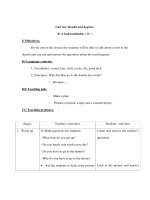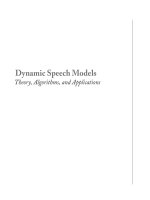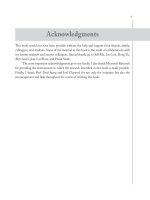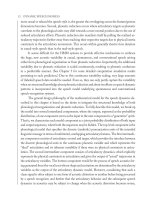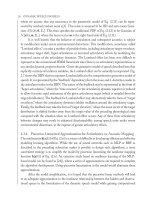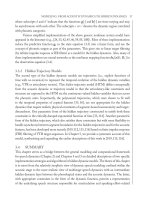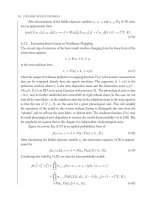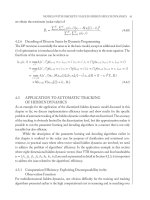Dynamic Speech ModelsTheory, Algorithms, and Applications phần 2 pps
Bạn đang xem bản rút gọn của tài liệu. Xem và tải ngay bản đầy đủ của tài liệu tại đây (305.26 KB, 13 trang )
P1: IML/FFX P2: IML
MOBK024-FM MOBK024-LiDeng.cls May 24, 2006 8:16
xi
Acknowledgments
This book would not have been possible without the help and support from friends, family,
colleagues, and students. Some of the material in this book is the result of collaborations with
my former students and current colleagues. Special thanks go to Jeff Ma, Leo Lee, Dong Yu,
Alex Acero, Jian-Lai Zhou, and Frank Seide.
The most important acknowledgments go to my family. I also thank Microsoft Research
for providing the environment in which the research described in this book is made possible.
Finally, I thank Prof. Fred Juang and Joel Claypool for not only the initiation but also the
encouragement and help throughout the course of writting this book.
P1: IML/FFX P2: IML
MOBK024-FM MOBK024-LiDeng.cls May 24, 2006 8:16
xii
P1: IML/FFX P2: IML/FFX QC: IML/FFX T1: IML
MOBK024-01 MOBK024-LiDeng.cls May 24, 2006 8:6
1
CHAPTER 1
Introduction
1.1 WHAT ARE SPEECH DYNAMICS?
In a broad sense, speech dynamics are time-varying or temporal characteristics in all stages
of the human speech communication process. This process, sometimes referred to as speech
chain [1], starts with the formation of a linguistic message in the speaker’s brain and ends with
the arrival of the message in the listener’s brain. In parallel with this direct information transfer,
there is also a feedback link from the acoustic signal of speech to the speaker’s ear and brain.
In the conversational mode of speech communication, the style of the speaker’s speech can be
further influenced by an assessment of the extent to which the linguistic message is successfully
transferred to or understood by the listener. This type of feedbacks makes the speech chain a
closed-loop process.
The complexityof the speech communicationprocess outlined above makes it desirable to
divide the entire process into modular stages orlevelsforscientificstudies.Acommon division of
the direct information transfer stages of the speech process, which this book is mainlyconcerned
with, is as follows:
•
Linguistic level: At this highest level of speech communication, the speaker forms the
linguistic concept or message to be conveyed to the listener. That is, the speaker decides
to say something linguistically meaningful. This process takes place in the language
center(s) of speaker’s brain. The basic form of the linguistic message is words, which are
organized into sentences according to syntactic constraints. Words are in turn composed
of syllables constructed from phonemes or segments, which are further composed of
phonological features. At this linguistic level, language is represented in a discrete or
symbolic form.
•
Physiological level: Motor program and articulatory muscle movement are involved at
this level of speech generation. The speech motor program takes the instructions, spec-
ified by the segments and features formed at the linguistic level, on how the speech
sounds are to be produced by the articulatory muscle (i.e., articulators) movement
over time. Physiologically, the motor program executes itself by issuing time-varying
commands imparting continuous motion to the articulators including the lips, tongue,
P1: IML/FFX P2: IML/FFX QC: IML/FFX T1: IML
MOBK024-01 MOBK024-LiDeng.cls May 24, 2006 8:6
2 DYNAMIC SPEECH MODELS
larynx, jaw, and velum, etc. This process involves coordination among various articu-
lators with different limitations in the movement speed, and it also involves constant
corrective feedback. The central scientific issue at this level is how the transformation
is accomplished from the discrete linguistic representation to the continuous articula-
tors’ movement or dynamics. This is sometimes referred to as the problem of interface
between phonology and phonetics.
•
Acoustic level: As a result of the articulators’ movements, acoustic air stream emerges
from the lungs, and passes through the vocal cords where a phonation type is developed.
The time-varying sound sources created in this way are then filtered by the time-varying
acoustic cavities shaped by the moving articulators in the vocal tract. The dynamics of
this filter can be mathematically represented and approximated by the changing vocal
tract area function over time for many practical purposes. The speech information
at the acoustic level is in the form of dynamic sound pattern after this filtering process.
The sound wave radiated from the lips (and in some cases from the nose and through the
tissues of the face) is the most accessible element of the multiple-level speech process
for practical applications. For example, this speech sound wave may be easily picked
by a microphone and be converted to analog or digital electronic form for storage or
transmission. The electronic form of speech sounds makes it possible to transport them
thousands of miles away without loss of fidelity. And computerized speech recognizers
gain access to speech data also primarily in the electronic form of the original acoustic
sound wave.
•
Auditory and perceptual level: During human speech communication, the speech sound
generated at the acoustic level above impinges upon the eardrums of a listener, where it
is first converted to mechanical motion via the ossicles of the middle ear, then to fluid
pressure waves in the medium bathing the basilar membrane of the inner ear invoking
traveling waves. This finally excites hair cells’ electrical, mechanical, and biochemical
activities, causing firings in some 30,000 human auditory nerve fibers. These various
stages of the processing carry out some nonlinear form of frequency analysis, with the
analysis results in the form of dynamic spatial–temporal neural response patterns. The
dynamic spatial–temporal neural responses are then sent to higher processing centers
in the brain, including the brainstem centers, the thalamus, and the primary auditory
cortex. The speech representation in the primary auditory cortex (with a high degree
of plasticity) appears to be in the form of multiscale and jointly spectro-temporally
modulated patterns. For the listener to extract the linguistic content of speech, a process
that we call speech perception or decoding, it is necessary to identify the segments and
features that underlie the sound pattern based on the speech representation in the
P1: IML/FFX P2: IML/FFX QC: IML/FFX T1: IML
MOBK024-01 MOBK024-LiDeng.cls May 24, 2006 8:6
INTRODUCTION 3
primary auditory cortex. The decoding process may be aided by some type of analysis-
by-synthesis strategies that make use of general knowledge of the dynamic processes at
the physiological and acoustic levels of the speech chain as the “encoder” device for the
intended linguistic message.
At all the four levels of the speech communication process above, dynamics play a central
role in shaping the linguistic information transfer. At the linguistic level, the dynamics are
discrete and symbolic, as is the phonological representation. That is, the discrete phonological
symbols (segments or features) change their identities at various points of time in a speech
utterance, and no quantitative (numeric) degree of change and precise timing are observed.
This can be considered as a weak form of dynamics. In contrast, the articulatory dynamics at
the physiological level, and the consequent dynamics at the acoustic level, are of a strong form
in that the numerically quantifiable temporal characteristics of the articulator movements and
of the acoustic parameters are essential for the trade-off between overcoming the physiological
limitations for setting the articulators’ movement speed and efficient encoding of the phono-
logical symbols. At the auditory level, the importance of timing in the auditory nerve’s firing
patterns and in the cortical responses in coding speech has been well known. The dynamic
patterns in the aggregate auditory neural responses to speech sounds in many ways reflect the
dynamic patterns in the speech signal, e.g., time-varying spectral prominences in the speech
signal. Further, numerous types of auditory neurons are equipped with special mechanisms (e.g.,
adaptation and onset-response properties) to enhance the dynamics and information contrast
in the acoustic signal. These properties are especially useful for detecting certain special speech
events and for identifying temporal“landmarks”as a prerequisitefor estimating the phonological
features relevant to consonants [2,3].
Often, we use our intuition to appreciate speech dynamics—as we speak, we sense the
motions of speech articulators and the sounds generated from these motions as continuous flow.
When we call this continuous flow of speech organs and sounds as speech dynamics, then we
use them in a narrow sense, ignoring their linguistic and perceptual aspects.
As is often said, timing is of essence in speech. The dynamic patterns associated with ar-
ticulation, vocaltract shaping, sound acoustics, and auditory response have the key property that
the timing axis in these patterns is adaptively plastic. That is, the timing plasticity is flexible but
not arbitrary. Compression of time in certain portions of speech has a significanteffect in speech
perception, but not so for other portions of the speech. Some compression of time, together
with the manipulation of the local or global dynamic pattern, can change perception of the style
of speaking but not the phonetic content. Other types of manipulation, on the other hand, may
cause verydifferent effects.In speech perception, certain speechevents,such as labialstop bursts,
flash extremely quickly over as short as 1–3 ms while providing significant cues for the listener
P1: IML/FFX P2: IML/FFX QC: IML/FFX T1: IML
MOBK024-01 MOBK024-LiDeng.cls May 24, 2006 8:6
4 DYNAMIC SPEECH MODELS
to identify the relevant phonological features. In contrast, for other phonological features, even
dropping a much longer chunk of the speech sound would not affect their identification. All
these point to the very special status of time in speech dynamics. The time in speech seems to
be quite different from the linear flow of time as we normally experience it in our living world.
Within the speech recognition community, researchers often refer to speech dynamics
as differential or regression parameters derived from the acoustic vector sequence (called delta,
delta–delta, or “dynamic” features) [4, 5]. From the perspective of the four-level speech chain
outlined above, such parameters can at best be considered as an ultra-weak form of speech
dynamics. We call them ultra-weak not only because they are confined to the acoustic domain
(which is only one of the several stages in the complete speech chain), but also because temporal
differentiation can be regarded hardly as a full characterization in the actual dynamics even
within the acoustic domain. As illustrated in [2,6,7], the acoustic dynamics of speech exhib-
ited in spectrograms have the intricate, linguistically correlated patterns far beyond what the
simplistic differentiation or regression can characterize. Interestingly, there have been numer-
ous publications on how the use of the differential parameters is problematic and inconsistent
within the traditional pattern recognition frameworks and how one can empirically remedy
the inconsistency (e.g., [8]). The approach that we will describe in this book gives the subject
of dynamic speech modeling a much more comprehensive and rigorous treatment from both
scientific and technological perspectives.
1.2 WHAT ARE MODELS OF SPEECH DYNAMICS?
As discussed above, the speech chain is a highly dynamic process, relying on the coordination
of linguistic, articulatory, acoustic, and perceptual mechanisms that are individually dynamic as
well. How do we make sense of this complex process in terms of its functional role of speech
communication? How do we quantify the special role of speech timing? How do the dynamics
relate to the variability of speech that has often been said to seriously hamper automatic speech
recognition? How do we put the dynamic process of speech into a quantitative form to enable
detailedanalyses? How can weincorporate the knowledge ofspeech dynamics intocomputerized
speech analysis and recognition algorithms? The answers to all these questions require building
and applying computational models for the dynamic speech process.
A computational model is a form of mathematical abstraction of the realistic physical
process. It is frequently established with necessary simplification and approximation aimed at
mathematical or computational tractability. The tractability is crucial in making the mathemat-
ical abstraction amenable to computer or algorithmic implementation for practical engineering
applications. Applying this principle, we define models of speech dynamics in the context of this
book as the mathematical characterization and abstraction of the physical speech dynamics.
These characterization and abstraction are capable of capturing the essence of time-varying
P1: IML/FFX P2: IML/FFX QC: IML/FFX T1: IML
MOBK024-01 MOBK024-LiDeng.cls May 24, 2006 8:6
INTRODUCTION 5
aspects in the speech chain and are sufficiently simplified to facilitate algorithm development
and engineering systemimplementation for speech processing applications. It ishighlydesirable
that the models be developed in statistical terms, so that advanced algorithms can be developed
to automatically and optimally determine any parameters in the models from a representative
set of training data. Further, it is important that the probability for each speech utterance be
efficiently computed under any hypothesized word-sequence transcript to make the speech
decoding algorithm development feasible.
Motivated by the multiple-stage view of the dynamic speech process outlined in the
preceding section, detailed computational models, especially those for the multiple generative
stages, can be constructed from the distinctive feature-based linguistic units to acoustic and
auditory parameters of speech. These stages include the following:
•
A discrete feature-organization process that is closely related to speech gesture over-
lapping and represents partial or full phone deletion and modifications occurring per-
vasively in casual speech;
•
a segmental target process that directs the model-articulators up-and-down and front-
and-back movements in a continuous fashion;
•
the target-guided dynamics of model-articulators movements that flow smoothly from
one phonological unit to the next; and
•
the static nonlinear transformation from the model-articulators to the measured speech
acoustics and the related auditory speech representations.
The main advantage of modeling such detailed multiple-stage structure in the dynamic
human speech process is that a highly compact set of parameters can then be used to cap-
ture phonetic context and speaking rate/style variations in a unified framework. Using this
framework, many important subjects in speech science (such as acoustic/auditory correlates of
distinctive features, articulatory targets/dynamics, acoustic invariance, and phonetic reduction)
and those in speech technology (such as modeling pronunciation variation, long-span context-
dependence representation, and speaking rate/style modeling for recognizer design) that were
previously studied separately by different communities of researchers can now be investigated
in a unified fashion.
Many aspectsof the above multitiereddynamicspeechmodel class, together withits scien-
tific background, have been discussed in [9]. In particular, the feature organization/overlapping
process, as is central to a version of computational phonology, has been presented in some
detail under the heading of “computational phonology.” Also, some aspects of auditory speech
representation, limited mainly to the peripheral auditory system’s functionalities, have been
elaborated in [9] under the heading of “auditory speech processing.” This book will treat these
P1: IML/FFX P2: IML/FFX QC: IML/FFX T1: IML
MOBK024-01 MOBK024-LiDeng.cls May 24, 2006 8:6
6 DYNAMIC SPEECH MODELS
topics only lightly, especially considering that both computational phonology and high-level
auditory processing of speech are still active ongoing research areas. Instead, this book will
concentrate on the following:
•
The target-based dynamic modeling that interfaces between phonology and
articulation-based phonetics;
•
the switching dynamic system modeling that represents the continuous, target-directed
movement in the “hidden” articulators and in the vocal tract resonances being closely
related to the articulatory structure; and
•
the relationship between the “hidden” articulatory or vocal tract resonance parame-
ters to the measurable acoustic parameters, enabling the hidden speech dynamics to
be mapped stochastically to the acoustic dynamics that are directly accessible to any
machine processor.
In this book, these three major components of dynamic speech modeling will be treated
in a much greater depth than in [9], especially in model implementation and in algorithm
development. In addition, this book will include comprehensive reviews of new research work
since the publication of [9] in 2003.
1.3 WHY MODELING SPEECH DYNAMICS?
What are the compelling reasons for carrying out dynamic speech modeling? We provide
the answer in two related aspects. First, scientific inquiry into the human speech code has
been relentlessly pursued for several decades. As an essential carrier of human intelligence
and knowledge, speech is the most natural form of human communication. Embedded in the
speech code are linguistic (and para-linguistic) messages, which are conveyed through the four
levels of the speech chain outlined earlier. Underlying the robust encoding and transmission of
the linguistic messages are the speech dynamics at all the four levels (in either a strong form
or a weak form). Mathematical modeling of the speech dynamics provides one effective tool
in the scientific methods of studying the speech chain—observing phenomena, formulating
hypotheses, testing the hypotheses, predicting new phenomena, and forming new theories.
Such scientific studies help understand why humans speak as they do and how humans exploit
redundancy and variability by way of multitiered dynamic processes to enhance the efficiency
and effectiveness of human speech communication.
Second, advancement of human language technology, especially that in automatic recog-
nition of natural-style human speech (e.g., spontaneous and conversational speech), is also
expected to benefit from comprehensive computational modeling of speech dynamics. Auto-
matic speech recognition is a key enabling technology in our modern information society. It
serves human–computer interaction in the most natural and universal way, and it also aids the
P1: IML/FFX P2: IML/FFX QC: IML/FFX T1: IML
MOBK024-01 MOBK024-LiDeng.cls May 24, 2006 8:6
INTRODUCTION 7
enhancement of human–human interaction in numerous ways. However, the limitations of
current speech recognition technology are serious and well known (e.g., [10–13]). A commonly
acknowledged and frequently discussed weakness of the statistical model (hidden Markov model
or HMM) underlying current speech recognition technology is the lack of adequate dynamic
modeling schemes to provide correlation structure across the temporal speech observation se-
quence [9, 13,14]. Unfortunately, due to a variety of reasons, the majority of current research
activities in this area favor only incremental modifications and improvements to the existing
HMM-based state-of-the-art. For example, while the dynamic and correlation modeling is
known to be an important topic, most of the systems nevertheless employ only the ultra-weak
form of speech dynamics, i.e., differential or delta parameters. A strong form of dynamic speech
modeling presented in this book appears to be an ultimate solution to the problem.
It has been broadly hypothesized that new computational paradigms beyond the conven-
tional HMM as a generative framework are needed to reach the goal of all-purpose recognition
technology for unconstrained natural-style speech, and that statistical methods capitalizing
on essential properties of speech structure are beneficial in establishing such paradigms. Over
the past decade or so, there has been a popular discriminant-function-based and conditional
modeling approach to speech recognition, making use of HMMs (as a discriminant function
instead of as a generative model) or otherwise [13, 15–19]. This approach has been grounded
on the assumption that we do not have adequate knowledge about the realistic speech process,
as exemplified by the following quote from [17]: “The reason of taking a discriminant function
based approach to classifier design is due mainly to the fact that we lack complete knowledge
of the form of the data distribution and training data are inadequate.” The special difficulty of
acquiring such distributional speech knowledge lies in the sequential nature of the data with a
variable and high dimensionality. This is essentially the problem of dynamics in the speech data.
As we gradually fill in such knowledge while pursing research in dynamic speech modeling, we
will be able to bridge the gap between the discriminative paradigm and the generative modeling
one, but with a much higher performancelevel thanthe systems at present. This dynamic speech
modeling approach can enable us to “put speech science back into speech recognition” instead of
treating speech recognition as a generic,looselyconstrained patternrecognition problem. Inthis
way, weare ableto develop models“that reallymodel speech,” andsuch modelscan beexpected to
providean opportunitytolay a foundationof the next-generationspeech recognitiontechnology.
1.4 OUTLINE OF THE BOOK
After the introduction chapter, the main body of this book consists of four chapters. They cover
theory, algorithms, and applications of dynamic speech models and survey in a comprehensive
manner the research work in this area spanning over past 20 years or so. In Chapter 2, a general
framework for modeling and for computation is presented. It provides the design philosophy
for dynamic speech models and outlines five major model components, including phonological
P1: IML/FFX P2: IML/FFX QC: IML/FFX T1: IML
MOBK024-01 MOBK024-LiDeng.cls May 24, 2006 8:6
8 DYNAMIC SPEECH MODELS
construct, articulatory targets, articulatory dynamics, acoustic dynamics, and acoustic distor-
tions. For each ofthese components, relevant speechscience literaturesare discussed, andgeneral
mathematical descriptions are developed with needed approximations introduced and justified.
Dynamic Bayesian networks are exploited to provide a consistent probabilistic language for
quantifying the statistical relationships among all the random variables in the dynamic speech
models, including both within-component and cross-component relationships.
Chapter 3 is devoted to a comprehensive survey of many different types of statistical mod-
els for speech dynamics, from the simple ones that focus on only the observed acoustic patterns
to the more advanced ones that represent the dynamics internal to the surface acoustic domain
and represent the relationship between these “hidden” dynamics and the observed acoustic dy-
namics. This survey classifies the existing models into two main categories—acoustic dynamic
models and hidden dynamic models, and provides a unified perspective viewing these models as
having different degrees of approximation to the realistic multicomponent overall speech chain.
Within each of these two main model categories, further classification is made depending
on whether the dynamics are mathematically defined with or without temporal recursion.
Consequences of this difference in the algorithm development are addressed and discussed.
Chapters 4 and 5 present two types of hidden dynamic models that are best developed
to date as reported in the literature, with distinct model classes and distinct approximation and
implementation strategies. They exemplify the state-of-the-arts in the research area of dynamic
speech modeling. The model described in Chapter 4 uses discretization of the hidden dynamic
variables to overcome the original difficulty of intractability in algorithms for parameter estima-
tion and for decoding the phonological states. Modeling accuracy is inherently limited to the
discretization precision, and the new computation difficulty arising from the large discretiza-
tion levels due to multi-dimensionality in the hidden dynamic variables is addressed by a greedy
optimization technique. Except for these two approximations, the parameter estimation and
decoding algorithms developed and described in this chapter are based on rigorous EM and
dynamic programming techniques. Applications of this model and the related algorithms to
the problem of automatic hidden vocal tract resonance tracking are presented, where the esti-
mates are for the discretized hidden resonance values determined by the dynamic programming
technique for decoding based on the EM-trained model parameters.
The dynamic speech model presented in Chapter 5 maintains the continuous nature in the
hidden dynamic values, and uses an explicit temporal function (i.e., defined nonrecursively) to
represent the hidden dynamics or “trajectories.” The approximation introduced to overcome the
original intractability problem is made by iteratively refining the boundaries associated with
the discrete phonological units while keeping the boundaries fixed when carrying out parameter
estimation. We show computersimulation results that demonstratethe desirable model behavior
in characterizing coarticulation and phonetic reduction. Applications to phonetic recognition
are also presented and analyzed.
P1: IML/FFX P2: IML
MOBK024-02 MOBK024-LiDeng.cls May 30, 2006 12:56
9
CHAPTER 2
A General Modeling and
Computational Framework
The main aim of this chapter is to set up a general modeling and computational framework,
based on the modern mathematical tool called dynamic Bayesian networks (DBN) [20, 21],
and to establish general forms of the multistage dynamic speech model outlined in the preceding
chapter.The overallmodelpresentedwithin thisframework iscomprehensivein nature,covering
all major components in the speech generation chain—from the multitiered, articulation-based
phonological construct (top) to the environmentally distorted acoustic observation (bottom).
The model is formulated in specially structured DBN, in which the speech dynamics at separate
levels of the generative chain are represented by distinct (but dependent) discrete and continuous
state variables and by their characteristic temporal evolution.
Before wepresent the modelandthe associated computational framework, wefirst provide
a general background and literature review.
2.1 BACKGROUND AND LITERATURE REVIEW
In recent years, the research community in automatic speech recognition has started attacking
the difficult problem in the research field—conversational and spontaneous speech recogni-
tion (e.g., [12,16, 22–26]). This new endeavor has been built upon the dramatic progress in
speech technology achieved over the past two decades or so [10, 27–31]. While the progress
has already created many state-of-the-art speech products, ranging from free-text dictation
to wireless access of information via voice, the conditions under which the technology works
well are highly limited. The next revolution in speech recognition technology should enable
machines to communicate with humans in a natural and unconstrained way. To achieve this
challenging goal, some of researchers (e.g., [3, 10, 11, 13, 20, 22, 32–39]) believe that the se-
vere limitations of the HMM should be overcome and novel approaches to representing key
aspects of the human speech process are highly desirable or necessary. These aspects, many of
which are of a dynamic nature, have been largely missing in the conventional hidden Markov
model (HMM) based framework. Towards this objective, one specific strategy would be to
P1: IML/FFX P2: IML
MOBK024-02 MOBK024-LiDeng.cls May 30, 2006 12:56
10 DYNAMIC SPEECH MODELS
place appropriate dynamic structure on the speech model that allows for the kinds of variations
observed in conversational speech. Furthermore, enhanced computational methods, including
learning and inference techniques, will also be needed based on new or extended models beyond
the HMM.
It has been well known that many assumptions in the current HMM framework are
inconsistent with the underlying mechanisms, as well as with the surface acoustic observations,
of the dynamic speech process (e.g., [13, 14]). However, a number of approaches, notably
known as the stochastic segment model, segmental HMM, and trended trajectory models
[14,40,41], which are intended to specifically overcome some of theseinconsistent assumptions,
have not delivered significant and consistent performance improvements, especially in large
speech recognition systems. Most of these approaches aimed mainly at overcoming the HMM’s
assumption of conditional IID (independent and identical distribution conditioned on the
HMMstate sequence).Yet theinconsistency betweenthe HMMassumptionsand theproperties
of the realistic dynamic speech process goes far beyond this “local” IID limitation. It appears
necessary not just to empirically fix one weak aspect of the HMM or another, but rather to
develop the new computational machinery that directly incorporates key dynamic properties of
the human speech process. One natural (but challenging) way of incorporating such knowledge
is to build comprehensive statistical generative models for the speech dynamics. Via the use of
Bayes theorem, the statistical generative models explicitly give the posterior probabilities for
differentspeechclasses,enabling effectivedecision rules to be constructed ina speech recognizer.
In discriminative modeling approaches, on the other hand, where implicit computation of the
posterior probabilities for speech classes is carried out, it is generally much more difficult to
systematically incorporate knowledge of the speech dynamics.
Along the directionof generative modeling, manyresearchers have, over recent years, been
proposing and pursuing research that extensively explores the dynamic properties of speech in
various forms and at various levels of the human speech communication chain (e.g., [24,32–34,
42–49]). Some approaches have advocatedthe use of the multitiered feature-based phonological
units, which control human speech production and are typical of human lexical representation
(e.g., [11, 50–52]). Other approaches have emphasized the functional significance of abstract,
“task” dynamics in speech production and recognition (e.g., [53, 54]). Yet other approaches
have focused on the dynamic aspects in the speech process, where the dynamic object being
modeled is in the space of surface speech acoustics, rather than in the space of the intermediate,
production-affiliated variables that are internal to the direct acoustic observation (e.g., [14,26,
55–57]).
Although dynamic modeling has been a central focus of much recent work in speech
recognition, the dynamic object being modeled, either in the space of “task” variables or of
acoustic variables, does not, and potentially may not be able to, directly take into account
the many important properties in realistic articulatory dynamics. Some earlier proposals and
P1: IML/FFX P2: IML
MOBK024-02 MOBK024-LiDeng.cls May 30, 2006 12:56
A GENERAL MODELING AND COMPUTATIONAL FRAMEWORK 11
empirical methods for modeling pseudo-articulatory dynamics or abstract hidden dynamics
for the purpose of speech recognition can be found in [42, 44–46, 58, 59]. In these studies,
the dynamics of a set of pseudo-articulators are realized either by filtering from sequentially
arranged, phoneme-specific target positions or by applying trajectory-smoothness constraints.
Due to the simplistic nature in the use of the pseudo-articulators, one important property
of human speech production, compensatory articulation, could not be taken into account,
because it would require modeling correlations among target positions of a set of articu-
lators. This has reduced the power of such models for potentially successful use in speech
recognition.
To incorporate essential properties in human articulatory dynamics—including compen-
satory articulation, target-directed behavior, and flexibly constrained dynamics due to biome-
chanical properties of different articulatoryorgans—in a statistical generative model ofspeech, it
appears necessary to use essential properties of realistic multidimensional articulators. Previous
attempts using the pseudo-articulators did not incorporatemost of such essential properties. Be-
cause much of the acoustic variation observed in speech that makes speech recognition difficult
can be attributed to articulatory phenomena, and because articulation is one key component in
the closed-loop human speech communication chain, it is highly desirable to developan explicit
articulation-motivated dynamic model and to incorporate it into a comprehensive generative
model of the dynamic speech process.
The comprehensive generative model of speech and the associated computational frame-
work discussed in this chapter consists of a number of key components that are centered on
articulatory dynamics. A general overview of this multicomponent model is provided next, fol-
lowed by details of the individual model components including their mathematical descriptions
and their DBN representations.
2.2 MODEL DESIGN PHILOSOPHY AND OVERVIEW
Spontaneous speech (e.g., natural voice mails and lectures) and speech of verbal conversations
among two or more speakers (e.g., over the telephone or in meetings) are pervasive forms of
human communication. If a computer system can be constructed to automatically decode the
linguistic messages contained in spontaneous and conversational speech, one will have vast
opportunities for the applications of speech technology.
What characterizes spontaneous and conversational speech is its casual style nature. The
casual style of speaking produces two key consequences that make the acoustics of spontaneous
and conversational speech significantly differ from that of the “read-style” speech: phono-
logical reorganization and phonetic reduction. First, in casual speech, which is called “hypo-
articulated” speech in [60], phonological reorganization occurs where the relative timing or
phasing relationship across different articulatory feature/gesture dimensions in the “orches-
trated” feature strands are modified. One obvious manifestation of this modification is that the
